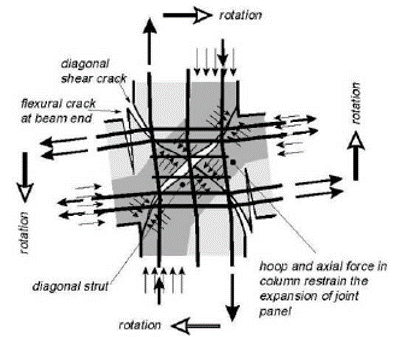Behaviour of Reinforced Concrete Beam Column Joints
Sagnificance of Geometry of the Joint
For ductile structures, it is necessary that the column should be strong than beams. The column width must be equal to or greater than the width of the beam to provide the strong column weak beam principle. It is generally desirable to provide stronger columns and to allow the yielding of beams in flexure prior to possible yielding in columns.
Significance of concrete strength
Strength of concrete affects the mechanism of failure, ductility and strength of joint. When the column and beam are made of same grade of concrete or when the column concrete is stronger than the beam concrete, the moment carrying capacity of joint increases with increase in axial level.
Joint with same grade of concrete in beam and column has more rotation capacity than any other combination . When the beam concrete is richer than column concrete, the behaviour of beam column joint is not consistent at different axial load levels. High strength concrete exhibits less ductile behavior.
This fact is important because increased ductility improves the performance of joint under large deformations.
Significance of reinforcement bars
Due to the complex stress distribution at the joint, its ductility and strength may be expected to depend on the area of tensile and compression reinforcement, and amount and distribution of transverse reinforcement.
The main reinforcement which is continued from adjacent members (beams and columns) into the joint core has prominent effect on behaviour of joint. The increase in the percentage of tensile reinforcement in beam increases the ultimate strength.
Influence of loading
One of the factors affecting the beam-column joint behaviour is the loading on the joint. Type, as well as amount of load, is effect the strength, efficiency, rotation, capacity and mechanism of failure. Particularly the axial load on column is dominant in affecting the joints behaviour.
An increase in the joint shear has a distinct effect on the load-carrying capacity of the joint. The severity of diagonal tension in the joint region is influenced by the magnitude of axial compressive load on the column.
Beam-Column Joint Failure Mechanism
Knowledge of stresses in joint and failure mechanism is necessary for the joint designs that can efficiently carry the forces. Beam column joints are usually designed following the generally accepted strong column-weak beam philosophy for reinforced concrete structures in seismic areas.This is desirable because the inelastic actions take place in beam plastic hinges; at the same time plastic hinges in the columns, which can result in a soft story mechanism, are avoided. However, in general the failure in a beam-column joint may occur in one of the following way;
- Formation of plastic hinge in beam portion near the beam-column interface.
- Formation of plastic hinge in column portion near the joint core.
- Formation of diagonal crack in the joint region.
